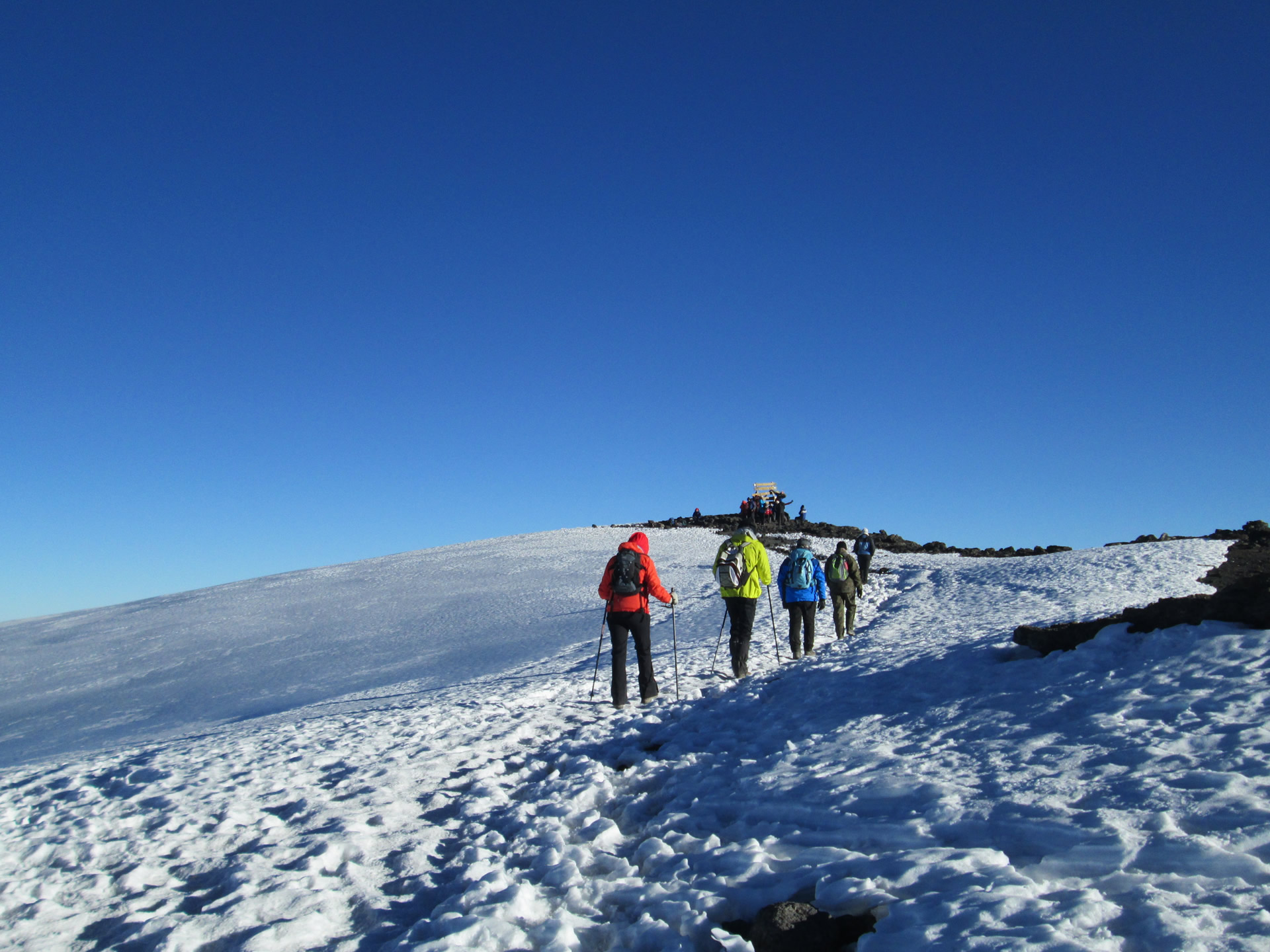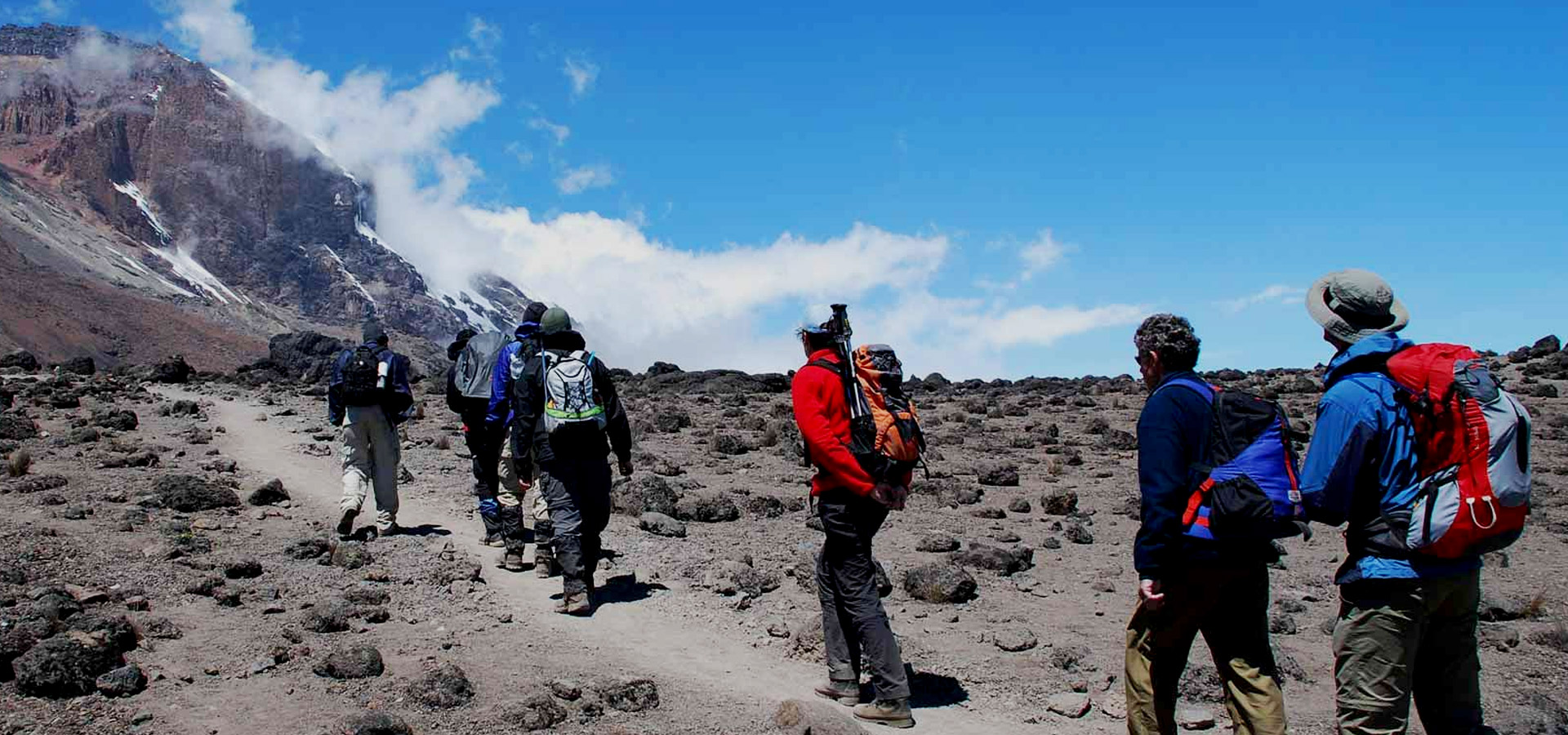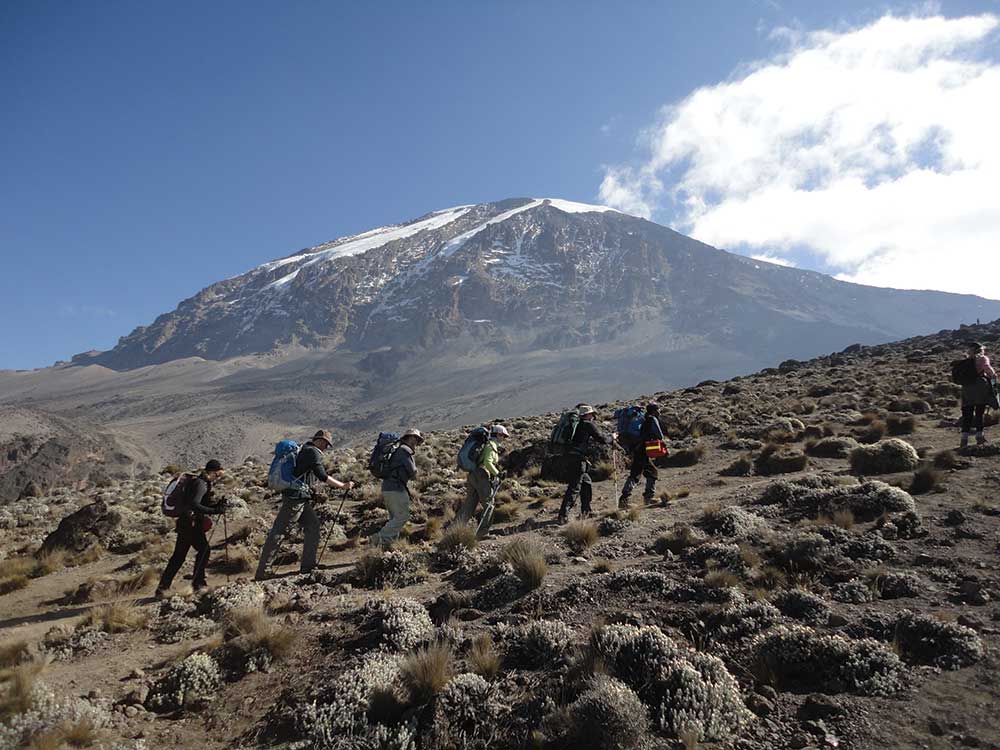MOUNT KILIMANJARO TREKKING
Duration
Range between 5 Days – 8 Days
Routes
Marangu, Machame, Lemosho and Rongai
Best Time To Visit
December to mid-March and mid-June to the end of October.
About Mount Kilimanjaro
Tanzania is home to the highest mountain in Africa – Mount Kilimanjaro (5895 metres), which is also the highest free-standing mountain in the world. Despite its height Kilimanjaro is one of the world’s most accessible high summits, with most climbers reaching the peak (Uhuru Peak) with little more than a walking stick, proper clothing and determination.
Climbing Mount Kilimanjaro is a virtual climatic world tour, from the tropical rain forest on the lower slopes and alpine heath, to an almost bare alpine desert and finally the wintry Arctic summit of snow and ice, just 3 degrees south of the Equator.
The ascent of Kilimanjaro can be done from four routes: Rongai, Machame, Lemosho and Marangu Route which is the easier one. Depending on which route one wants to take, the climb of Kilimanjaro can take between four to six nights on the mountain. The two most popular routes are Marangu and Machame. On the Marangu Route, accommodation is in alpine huts while on Machame Route it is camping throughout.

Kilimanjaro Trekking (Routes)
General Information for all Trekkers
1.TREKKING GEAR AND WARM CLOTHING: CHECKLIST OF RECOMMENDED ITERMS:
- WATERPROOF RUCKSACK & DAYPACK
- SLEEPING-BAG (at least 3 seasons)
- WHISTLE
- BOOTS & LIGHT TRAINERS
- BALACLAVA OR WOOLEN HAT
- SCARF
- SNOW GOGGLES/SUN GLASSES
- GAITERS (useful when encountering snow, scree, etc)
- WATER BOTTLE
- FIRST AID KIT & INSECT REPELLANT
- GLOVES & MITTENS (synthetic preferable)
- WALKING POLE
- PANTS & JACKET (waterproof + windproof)
- ROLL MATS OR INSULATION PADS (camping routes)
- SOME PLASTIIC BAGS
- SOME PLASTIC BAGS LONG SLEEVED SHIRT
- SEVERAL PAIRS OF SOCKS
- SWEATERS/JUMPERS
- SMALL TOWEL & WASH KIT
- THERMAL UNDER WEAR
- ANORAK/RAINCOAT
- TOILETRY REQUIREMENTS
- SUN PROTECTION CREAM & LIP SALVE
- FLASHLIGHT (head mounted preferable) WITH SPARE BATTERIES
- Some of the trekking gear listed may be available for hire at the Kilimanjaro park gates, however choices are limited and in some instances this option may not be available, also prices can vary.
2.MEDICAL CONDITIONS:
Please note: Kilimanjaro is a big mountain, it should NOT be under-estimated. The trek involves hard work and various weather patterns are encountered at different Stages of the trek. It is important that the following is understood:
It is assumed that each trekker has consulted his/her doctor about being Physically fit to trek Mt. Kilimanjaro, as well as acquiring information on various mountain/altitude related sicknesses, prior to booking the trek.
We will assume you have received prior consent from your G.P & Dentist. If you have a cough, cold, or any respiratory illnesses, diabetes; cardiac problems, pulmonary diseases, (or any illness due to irregular blood sugar levels) DO NOT attempt to trek these mountain, it can be dangerous and could prove fatal. If you do attempt it anyway (we need written approval from your GP), park regulations restrict you to trek above 3,000m. If you have any physical disabilities please let us know. Extensive reading on mountain/high altitude related & tropical diseases are highly recommended.
3. MOUNTAIN SICKNESS:
Every trekker should be aware of the following conditions that are likely to occur on the mountain, so necessary steps should be taken to avoid them. Exhaustive reading on any mountain/high altitude related and tropical sicknesses is the client’s responsibility. Conditions, symptoms and remedies suggested here are by no means exhaustive.
Frostbite: As a result of low temperatures, the destruction of soft tissues in the fingers and toes, etc, can occur.
Prevention: Good gloves (with insulation), thick wool socks would help keep toes warm.
Hypothermia: Condition associated with the lowering of body’s core temperature, Symptoms include: shivering, mental & emotional dulling, severe hypothermia can lead to total disorientation, confusion and ultimately death. Improper clothing, getting wet from rain/perspiration, exhaustion, causes this.
Prevention: Proper clothing (dry + that allow for ventilation, water proofing), keeping warm & active.
Acute Mountain Sickness: This is a direct result of failure to acclimatize properly. The best way to avoid this is to ascend slowly, take care to eat & drink properly, the symptoms include nausea, headache (common), vomiting, fatigue, sleeplessness, swelling of hands/feet. Please note some of these symptoms are common for all the trekkers however, if food & fluid intake has been adequate and symptoms still persist and are severe, you should descend immediately. Please ask the guide for assistance.
Pulmonary oedema: Symptoms include: shortness of breath even at rest, gurgling breath sounds that can be heard, Production of frothy white sputum, cough (sometimes sputum is blood tinged).
Celebral Oedema: Symptoms include severe headache, lack of co-ordination, and hallucinations that the patient does not acknowledge.
Remedy: These are serious conditions, and dangerous; please advise your guide about your situation and do not attempt going any further up the mountain, at this point it is recommended that you be taken to a lower position and if necessary, the rescue team must be summoned.
4. WATER:
To avoid dehydration, it recommended that every trekker consume 1.5-3 litres of water per day, this will also help your body acclimatise with the high altitude. Note we provide bottled water on day 1 of the trek, and thereafter we provide treated water. (You can bring your own water filters if you wish)
5. PACE:
Maintaining a slow pace while trekking, drinking lots of water will help your body with the acclimatisation process as well as avoid many mountain-related sicknesses.
6. PARK REGULATIONS:
Park regulations are to be observed at all times (These are posted at each park entry point, if doubt please ask your guide).
7. PERSONAL BAGGAGE:
Kindly limit your personal luggage (warm clothes sleeping bag) to 15kg per person maximum. This is the maximum allowable weight that is carried by each porter on the mountain. Suitcases will NOT be carried; however, backpacks/duffle bags/soft bags are ok as these make it easier to transport during the trek as well as the safari.
Items that are not needed during the trek or safari (apart from money, passports and valuables) can be left at our offices at no extra cost. We suggest that you have a day pack that YOU WOULD CARRY, unless otherwise arranged, which for your comfort must weigh no more that 5kgs max. This will contain your camera, water bottle, binoculars any medication, toiletry requirements, raincoat, extra t-shirt, that you may use during the day whilst on trek. This is aimed at making sure that you enjoy your trek-we do not want you to tire yourself!!
It is important to note that your bag should not weigh more than 15kg,if it is in excess even 1kg, an extra porter will be required so you will be changed US$ 15/day per porter, payable before departing our offices for the trek
8. ITINERARY:
The client has no right to effect a change in program without approval from the company or unless in case of an emergency.
9. SHORTENING OF TREK DURATION AGREED UPON:
Should any client shorten the trek due to whatever reason (sickness, tiredness, etc), there will be no refund and the client will be responsible for the transfer cost as well as any other expenses e.g. Hotel, hospital bills, etc.
10. INSURANCE:
It is the client’s responsibility to effect suitable insurance cover. (E.g. insurance covering baggage, travel, medical, personal injury and death, etc). Roy Safaris will assume, with your signed form that you have suitable insurance cover.
11. PERSONAL BAGGAGE:
Kindly limit your personal luggage (warm clothes sleeping bag) to 15kg per person maximum. This is the maximum allowable weight that is carried by each porter on the mountain. Suitcases will NOT be carried; however, backpacks/duffle bags/soft bags are ok as these make it easier to transport during the trek as well as the safari.
Items that are not needed during the trek or safari (apart from money, passports and valuables) can be left at our offices at no extra cost. We suggest that you have a day pack that YOU WOULD CARRY, unless otherwise arranged, which for your comfort must weigh no more that 5kgs max. This will contain your camera, water bottle, binoculars any medication, toiletry requirements, raincoat, extra t-shirt, that you may use during the day whilst on trek. This is aimed at making sure that you enjoy your trek-we do not want you to tire yourself!!
It is important to note that your bag should not weigh more than 15 kg; an extra porter will be required so you will be charged extra before departure for the trek.
12. PASSPORT AND INSURANCES:
Kindly come with a copy of your passport and insurance will be needed so that we have it in the file, in case of any emergency.
13. YOU WILL BE REQUIRED TO SIGN A WAIVER:
14. TIPPING/GRATUITIES:
Tips for mountain crew tend to average some US$ 250 – US$ 300 per person. All climbers’ contributions are usually added together and the total amount is presented to the chief guide at Mweka Gate. Our guides always divide these tips fairly amongst their crew according to a customary scale that is determined by the responsibilities and experience of each staff member. This is usually done once you finish the trek.
14. GUIDES:
Are highly trained on:
- High Altitude Mountain Sickness (AMS), signs and treatment.
- High Altitude Cerebral Edema (HACE) signs and treatment.
- High Altitude Pulmonary Edema (HAPE) signs and treatments.
- Amref Flying Doctors emergency evacuation course- SPECIALISED ON high mountain emergency evacuation procedures. (ORGANISED BY AMREF FLYING DOCTOR SOCIETY).
Qualification of Guides compiles with the International Wilderness First Air Rescue procedures.










